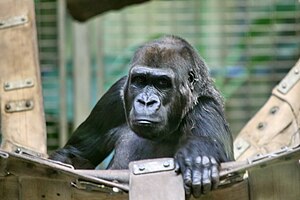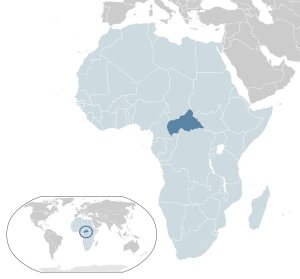

The wildlife of the Central African Republic is in the vast natural habitat in the Central African Republic (CAR) located between the Congo Basin's rain forests and large savannas, where the human density was smaller than 0.5 per km2 prior to 1850. The forest area of 22.755 million, considered one of the richest storehouses of wildlife spread over national parks, hunting reserves and community hunting areas, experienced an alarming loss of wildlife because of greed for ivory and bushmeat exploitation by hunters – mostly Arab slavers from across the borders of the Central African Republic with Chad and Sudan.[1][2][3]
Realizing the serious threat to the wildlife, the colonists – French administration – in 1935 and later the government of the CAR, enacted laws and created national parks and preserves, which covered 16.6% of the country. The three most coveted national parks are the Manovo-Gounda St. Floris National Park with its reported "greatest concentrations of hippos in the world", the Bamingui-Bangoran National Park in the north; and the Dzanga-Sangha Reserve which covers rain forests.[3] The Manovo-Gounda-Saint-Floris National Park, in particular was inscribed to the UNESCO List of World Heritage Sites in 1988 in recognition of the diversity of life present within it in respect of its wealth of flora and fauna.[4] In 2014, the Chinko Nature Reserve in eastern CAR was granted management through a public-private partnership with the Central African Republic Ministry of Wildlife, Water and Forestry and African Parks, a conservation NGO that takes on the direct, long-term management of national parks and protected areas in partnership with governments to save wildlife, restore landscapes and ensure sustainable livelihoods for local communities. African Parks has a mandate to manage this protected area, now referred to as the Chinko Project, for the next 50 years.
However, the legal instruments were not effective in controlling poaching activities for profits, as institutional support for protected areas has all along been weak with hunters and loggers not letting go their activities even in national parks. Most of the timber extracted from the CAR is exported to Europe.[2]
Situated in the east of the CAR, Chinko is one of the region's only remaining strongholds for numerous species including the highly threatened Lord Derby eland, bongo and chimpanzees. This important ecosystem, however, is under tremendous pressure from militarized ivory poachers and intense levels of cattle grazing.
The richness of the wildlife of the Central African Republic is reflected in its about 3,600 species of plants, 663 birds, 209 mammals (includes two endemic species and 11 threatened species[5]), 187 reptiles and 29 amphibians.[2]
- ^ "Has the final countdown to wildlife extinction in Northern Central African Republic begun?" (PDF). Africa Journal Ecology:Blackwell Publishing Ltd. 2009. Retrieved 21 April 2011.
- ^ a b c "Central African Republic". mongabay.com. Retrieved 21 April 2011.
- ^ a b "Parks, Reserves, and Other Protected Areas in Central African Republic". Parks.it. Retrieved 21 April 2011.
- ^ "Brief Description". unesco.org. Retrieved 21 April 2011.
- ^ "Animal Info – Central African Republic". animalinfo.org. Retrieved 22 April 2011.
© MMXXIII Rich X Search. We shall prevail. All rights reserved. Rich X Search
